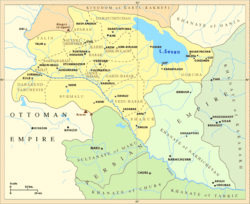Erivan Khanate

The Erivan (Yerevan) khanate(Persian: ایروان) (Turkish: Revan Hanlığı) was a Muslim controlled principality under the dominion of the Persian Empire between 1747 and 1828. Its territory roughly corresponded to most of present-day central Armenia, most of the Iğdır Province of present-day Turkey, and the Sharur and Sadarak rayons of present-day Azerbaijan's province of Nakhichevan. As a result of the Persian defeat in the last Russo-Persian War, it was ceded to the Russian Empire in accordance with the Treaty of Turkmenchay. Immediately following this, the territories of the former Yerevan khanate and the Nakhichevan khanate were joined to form the Armenian oblast.
During the existence of the Erivan khanate, its population consisted primarily of Armenians, Persians (settled largely around the capital), Turkic tribes (both settled and seminomadic), Kurds (largely nomadic).[1] Shia Islam was the predominate faith of the khanate (with some Kurds of the Sunni school). [1] Yazidis were also known to be numerous. [1] Armenians formed less than 20% of the population [1] as a result of Shah Abbas I's deportation of much of the Armenian population from the Ararat valley and the surrounding region in 1605.[2]
After the incorporation of the Erivan khanate into the Russian Empire in 1828, many Muslims (Azeri Tartars, Kurds, Lezgis and various nomadic tribes) left the area and were replaced with tens of thousands of Armenian refugees from Persia. Such migrations, albeit on a lesser scale, continued until the end of the 19th century.[3] By 1832 Muslims in what had been the Erivan khanate were already outnumbered by Armenians.[4] According to the Brockhaus and Efron Encyclopedic Dictionary, by the beginning of the 20th century a significant population of Muslims still lived in Russian Armenia. They numbered about 300,000 persons or 37.5% in Russia's Erivan Governorate (roughly corresponding to most of present-day central Armenia, the Iğdır Province of Turkey, and Azerbaijan's Nakhichevan exclave).[5]
References
- ^ a b c d Hewsen, Robert H. (2001). Armenia: A Historical Atlas. The University of Chicago Press. pp. p. 168. ISBN 0-226-33228-4.
{{cite book}}:|pages=has extra text (help) - ^ von Haxthausen, Baron (2000). Transcaucasia: Sketches of the Nations and Races between the Black Sea and the Caspian. Adamant Media Corporation. pp. p. 252. ISBN 1402183674.
{{cite book}}:|pages=has extra text (help) - ^ Conflict in Nagorno-Karabakh, Abkhazia and South Ossetia: A Legal Appraisal by Tim Potier. Martinus Nijhoff Publishers. 2001. p.2 ISBN 9041114777
- ^ Small Nations and Great Powers: A Study of Ethnopolitical Conflict in the Caucasus by Svante Cornell. Routledge. 2001. p.67 ISBN 0700711627
- ^ (Russian) Brockhaus and Efron Encyclopedic Dictionary: Erivan Governorate
